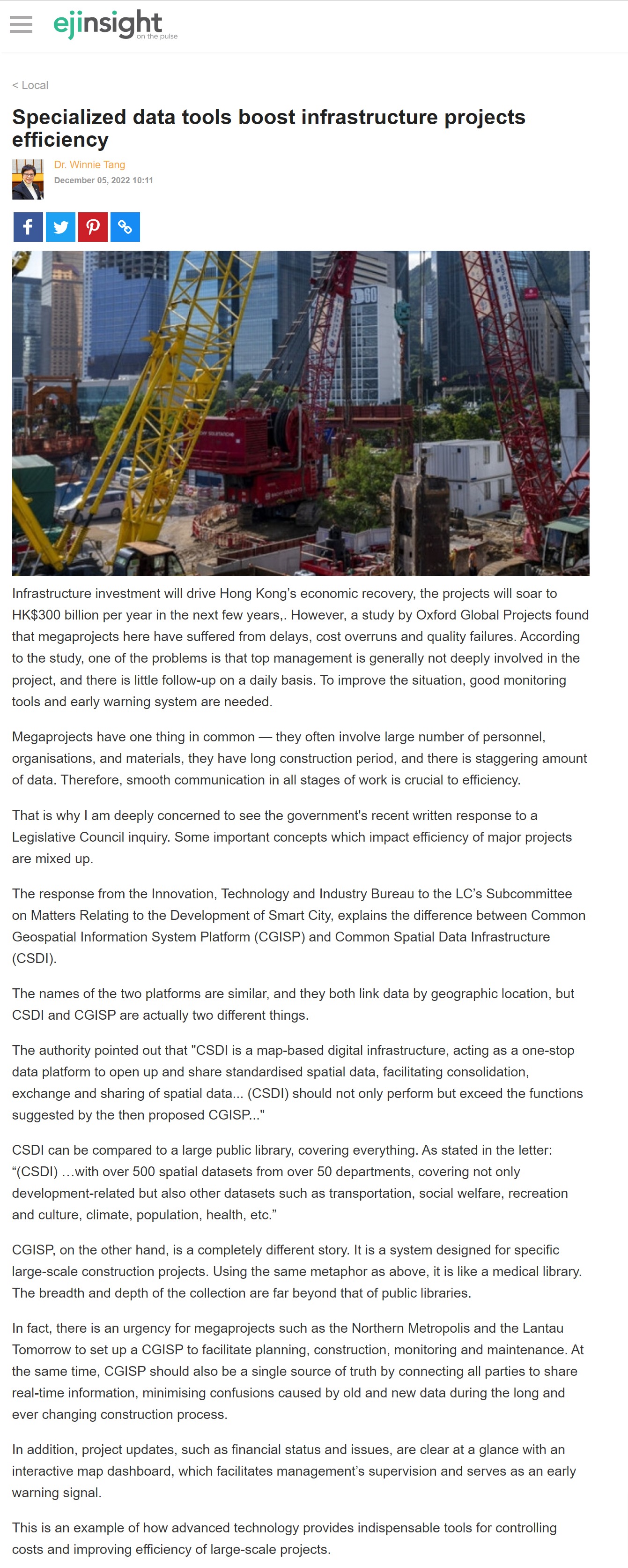網上版請按此

Specialized data tools boost infrastructure projects efficiency
Infrastructure investment will drive Hong Kong's economic recovery, the projects will soar to HK$300 billion per year in the next few years,. However, a study by Oxford Global Projects found that megaprojects here have suffered from delays, cost overruns and quality failures. According to the study, one of the problems is that top management is generally not deeply involved in the project, and there is little follow-up on a daily basis. To improve the situation, good monitoring tools and early warning system are needed.
Megaprojects have one thing in common — they often involve large number of personnel, organisations, and materials, they have long construction period, and there is staggering amount of data. Therefore, smooth communication in all stages of work is crucial to efficiency.
That is why I am deeply concerned to see the government's recent written response to a Legislative Council inquiry. Some important concepts which impact efficiency of major projects are mixed up.
The response from the Innovation, Technology and Industry Bureau to the LC's Subcommittee on Matters Relating to the Development of Smart City, explains the difference between Common Geospatial Information System Platform (CGISP) and Common Spatial Data Infrastructure (CSDI).
The names of the two platforms are similar, and they both link data by geographic location, but CSDI and CGISP are actually two different things.
The authority pointed out that "CSDI is a map-based digital infrastructure, acting as a one-stop data platform to open up and share standardised spatial data, facilitating consolidation, exchange and sharing of spatial data... (CSDI) should not only perform but exceed the functions suggested by the then proposed CGISP..."
CSDI can be compared to a large public library, covering everything. As stated in the letter: "(CSDI) …with over 500 spatial datasets from over 50 departments, covering not only development-related but also other datasets such as transportation, social welfare, recreation and culture, climate, population, health, etc."
CGISP, on the other hand, is a completely different story. It is a system designed for specific large-scale construction projects. Using the same metaphor as above, it is like a medical library. The breadth and depth of the collection are far beyond that of public libraries.
In fact, there is an urgency for megaprojects such as the Northern Metropolis and the Lantau Tomorrow to set up a CGISP to facilitate planning, construction, monitoring and maintenance. At the same time, CGISP should also be a single source of truth by connecting all parties to share real-time information, minimising confusions caused by old and new data during the long and ever changing construction process.
In addition, project updates, such as financial status and issues, are clear at a glance with an interactive map dashboard, which facilitates management's supervision and serves as an early warning signal.
This is an example of how advanced technology provides indispensable tools for controlling costs and improving efficiency of large-scale projects.
Dr. Winnie Tang
Adjunct Professor, Department of Computer Science, Faculty of Engineering; Department of Geography, Faculty of Social Sciences; and Faculty of Architecture, The University of Hong Kong